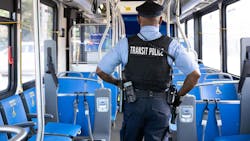SEPTA, BART continue to reduce crime on respective systems during Q1 2025
The Southeastern Pennsylvania Transportation Authority (SEPTA) and Bay Area Rapid Transit (BART) are making efforts to cut down on crime and make the systems safer for riders.
SEPTA’s crime rates hold steady
Incidents of crime on SEPTA systems in most categories held steady during the first quarter of 2025 after 2024 featured the largest one-year drop in serious incidents recorded by the SEPTA Transit Police Department. According to SEPTA, there were reductions in shootings and aggravated assaults compared to the same period last year. Total crime on the system is 28 percent lower than the three-year average preceding 2024.
“These results are proof that what we are doing is working,” said SEPTA Interim General Manager Scott A. Sauer. “Safety is SEPTA’s highest value, and over the past three years, we have more than doubled spending on safety, security and cleaning priorities – demonstrating our commitment to deliver the safest, cleanest and most reliable service.”
SEPTA continues to hire record numbers of new police officers with 248 uniformed officers on staff, a 27 percent increase since the end of 2022 and the largest police force in over a decade. An additional 13 officers are expected to graduate from police academy this June.
The agency also continues to combat fare evasion through enhanced policing and new technology and infrastructure. SEPTA says increased enforcement of fare evasion has yielded broader customer safety benefits, with fare evasion citations leading to hundreds of arrests of individuals wanted for other crimes.
“With additional police officers, we can take a data driven approach to fare evasion, evaluating officer interactions, camera footage and station revenue to determine hot spots for fare evasion, deploy police officers and remove offenders from the system,” said SEPTA Transit Police Chief Charles Lawson.
The agency is installing more full-height fare gates that are designed to prevent fare evaders from jumping over or crawling under turnstiles. SEPTA notes the gates were an effective mechanism to deter, detect and quantify fare evasion during a pilot at 69th St. Transit Center.
SEPTA has hired 100 additional staff in the past year, and the authority now has more than 700 cleaners and maintenance personnel deployed strategically to keep stations and vehicles cleaner and respond to issues as they arise. The agency notes new initiatives like pit crews that perform mid-route cleaning of Broad Street and Market-Frankford Line cars throughout the service day and an emphasis on station deep cleaning are starting to be reflected in improved scores in customer satisfaction surveys.
The full first quarter 2025 report is available on SEPTA’s website.
BART’s violent crime drops by 23 percent
During the first quarter of 2025, violent crime on BART fell by 23 percent compared to 2024. BART notes the latest drop comes on top of a 17 percent decline in overall crime on BART in 2024.
Rep. Lateefah Simon (D-CA-12) recently met with BART in Washington, D.C., to get an in-person update on the progress BART has made in recent months on rider-focused safety, cleanliness and accessibility improvements. Simon previously served as BART Board president and BART District 7 board member.
“I believe that BART will be the nation’s safest transit institution,” Simon said. “You know why? There are [transit-dependent] folks like me who don’t have a choice, who aren’t jiggling car keys. They are riding BART because unfortunately, mobility in many parts of the Bay Area is still a privilege. We’ve made it a right here at BART.”
BART says the implementation of BART’s Safe and Clean Plan has been at the forefront of putting rider safety first. The plan includes boosting visible train patrols, installing next generation fare gates, right-sizing trains to create safer spaces, improving station lighting and other rider-focused initiatives.
“This steep decline in our violent crime rate would not be possible without the hard work of the people of the BART Police Department,” said BART Police Chief Kevin Franklin. “We will continue to deploy sworn officers, as well as non-sworn unarmed crisis intervention specialists, transit ambassadors, fare inspectors and community service officers to maximize our presence in the system and ensure BART is welcoming for all.”
The agency has already installed next generation fare gates at 29 stations and remains on track to have the new, more durable gates in place at all 50 stations by the end of 2025. BART notes the new gates are improving the station environment by serving as a deterrent against many instances of fare evasion and reducing the amount of unwanted activity in the system. According to the agency, a recent survey found the number of riders who have reported seeing fare evasion on BART has dropped by almost a third since installation work began for the new gates.
About the Author
Brandon Lewis
Associate Editor
Brandon Lewis is a recent graduate of Kent State University with a bachelor’s degree in journalism. Lewis is a former freelance editorial assistant at Vehicle Service Pros in Endeavor Business Media’s Vehicle Repair Group. Lewis brings his knowledge of web managing, copyediting and SEO practices to Mass Transit Magazine as an associate editor. He is also a co-host of the Infrastructure Technology Podcast.


